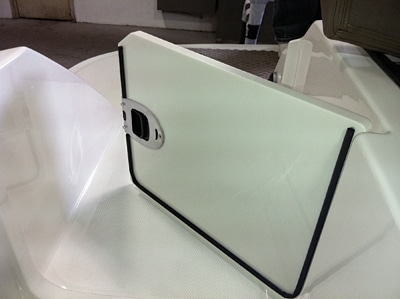When Sea Ray called to say it had implemented a program that reduced noise levels aboard its boats by as much as 12 decibels, I politely reminded the company that I wasn’t the type prone to wearing a cap lined with tin foil. I’ve been collecting “dB(A)” readings for Boating boat tests for 16 years and never saw noise levels reduced by anywhere near that amount. A decibel is a ratio representing a 10-base logarithm and used to measure the loudness of sound. A change of just one decibel represents an exponential change in volume. Scientists consider a 5 dB difference significantly noticeable to the human ear. Twelve decibels? Couldn’t be. But Sea Ray persisted. So I boarded an airplane to the boatbuilder’s Knoxville, Tennessee, headquarters to judge the new technology it’s installing in select model boats, called Quiet Ride, with my own ears — and a decibel meter.
The main sound culprit aboard is vibration from the engine, props and action of the hull moving through the water. Thwarting vibration at these various sources and preventing vibrations that can’t be damped from traveling to the ears of the crew are the prongs of the spear with which Sea Ray killed the noise. Sound is cumulative, coming from a variety of sources and adding up to the racket that makes conversation difficult, wears us down sooner than we’d normally tire and can even cause hearing damage with prolonged exposure, according to experts. So Sea Ray threw that spear often, and at some targets that might surprise you.
You can easily see that Sea Ray installed gaskets or bumpers on all hatches and doors aboard. You might also notice the rare earth magnet used to secure the swim ladder hatch, and the robust dog latches that now replace the rattle-prone slam latches used widely in the industry. One surely can’t miss the heavy insulation lining the engine compartment. The sturdy spring brackets used to stow accessories like table pedestals also add to the hush. But there is plenty you can’t see unless you tour the production line like I did.
One of the coolest implementations I saw was a material that looks like Kraft paper, which Sea Ray uses in its hull laminate. This fabric converts vibration into heat, preventing sound from traveling past it. It’s laid on the hull at the chines. Sea Ray says the fabric creates no loss of strength or integrity, a fact I confirmed in talks with other boatbuilders.

Bulkheads and panels surrounding the engine compartment are constructed with acoustical insulation.Foam placed between the deck and hull reduces squeaks and creaks. A rubber gasket beds the joint between engine box and deck. Foam sprayed in the bow damps the vibration as the boat encounters waves. The structural liners are built without voids to negate reverberation. Robotic drilling assures precise installation of hardware, so cleats, chocks, hinges and other deck jewelry don’t add to the din. As the boat got quieter, the engineering team discovered more and more sources of noise, and attacked them. Examples include a gasket beneath the windshield to prevent air leaks from whistling and acoustically insulated drink holders to keep noise from entering the cockpit. What’s next? Sea Ray is considering developing its own blower motor to replace the noisy ones currently on the market.
A 12 dB reduction? Running identically powered 250 SLX bowriders, one with Quiet Ride and one without, I recorded a 9 dB(A) reduction in noise at 4,000 rpm while seated at the aft bench. The actual readings were 92 and 83 dB(A). Note that we had less wind during our trials than Sea Ray had during its tests. We also used a different brand of sound meter, which might have affected the results. Still, a 9 dB reduction is outstanding: the average sound level for similar boats at that speed, according to our test database on our website, is 94 decibels. Additionally, the boat without Quiet Ride produced a three-cycles-per-second thrum in the soles of my bare feet. Aboard the 250 SLX with Quiet Ride I could not feel enough vibration to quantify it.
Noise is tiring, inconvenient and grudgingly accepted by boaters. Sea Ray’s Quiet Ride technology proves that it doesn’t have to be part of the boating experience.
Key Features
-Noise reduction is achieved via a boatwide system of techniques and technologies.
-A special hull material converts vibration to heat, effectively “dead-ending” sound.
-Gaskets, bumpers and acoustic-filled bulkheads quell noise while maintaining strength and allowing the engine to breathe.
Sound Around
0 Decibels: Mosquito at 10 feet
70 Decibels: Normal conversation; 3 to 5 feet
90-95 Decibels: Train whistle at 500 feet
125 Decibels: Pneumatic riveter
198 Decibels: Volcano









